哺乳动物英文介绍共28页
- 格式:ppt
- 大小:3.14 MB
- 文档页数:28
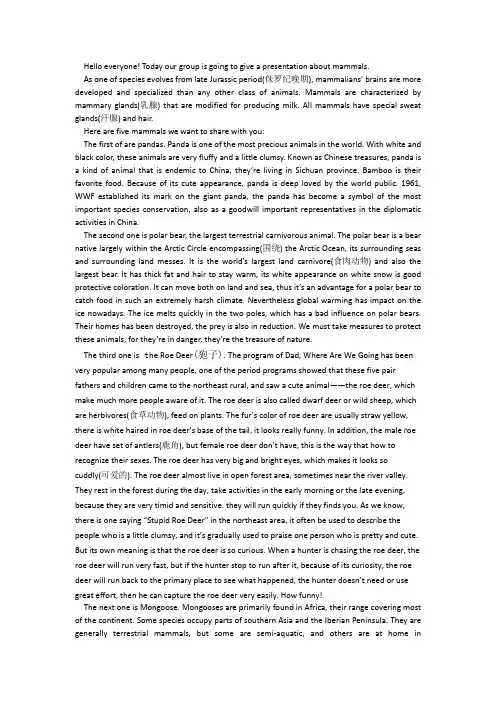
Hello everyone! Today our group is going to give a presentation about mammals.As one of species evolves from late Jurassic period(侏罗纪晚期), mammalians’ brains are more developed and specialized than any other class of animals. Mammals are characterized by mammary glands(乳腺) that are modified for producing milk. All mammals have special sweat glands(汗腺) and hair.Here are five mammals we want to share with you:The first of are pandas. Panda is one of the most precious animals in the world. With white and black color, these animals are very fluffy and a little clumsy. Known as Chinese treasures, panda is a kind of animal that is endemic to China, they’re living in Sichuan province. Bamboo is their favorite food. Because of its cute appearance, panda is deep loved by the world public. 1961, WWF established its mark on the giant panda, the panda has become a symbol of the most important species conservation, also as a goodwill important representatives in the diplomatic activities in China.The second one is polar bear, the largest terrestrial carnivorous animal. The polar bear is a bear native largely within the Arctic Circle encompassing(围绕) the Arctic Ocean, its surrounding seas and surrounding land messes. It is the world’s largest land carnivore(食肉动物) and also the largest bear. It has thick fat and hair to stay warm, its white appearance on white snow is good protective coloration. It can move both on land and sea, thus it’s an advantage for a polar bear to catch food in such an extremely harsh climate. Nevertheless global warming has impact on the ice nowadays. The ice melts quickly in the two poles, which has a bad influence on polar bears. Their homes has been destroyed, the prey is also in reduction. We must take measures to protect these animals, for they’re in danger, they’re the treasure of nature.The third one is t he Roe Deer(狍子).The program of Dad, Where Are We Going has been very popular among many people, one of the period programs showed that these five pair fathers and children came to the northeast rural, and saw a cute animal——the roe deer, which make much more people aware of it. The roe deer is also called dwarf deer or wild sheep, which are herbivores(食草动物), feed on plants. The fur’s color of roe deer are usually straw yellow, there is whi te haired in roe deer’s base of the tail, it looks really funny. In addition, the male roe deer have set of antlers(鹿角), but female roe deer don’t have, this is the way that how to recognize their sexes. The roe deer has very big and bright eyes, which makes it looks socuddly(可爱的). The roe deer almost live in open forest area, sometimes near the river valley. They rest in the forest during the day, take activities in the early morning or the late evening, because they are very timid and sensitive. they will run quickly if they finds you. As we know, there is one saying “Stupid Roe Deer” in the northeast area, it often be used to describe the people who is a little clumsy, and it’s gradually used to praise one person who is pretty and cute. But its own meaning is that the roe deer is so curious. When a hunter is chasing the roe deer, the roe deer will run very fast, but if the hunter stop to run after it, because of its curiosity, the roe deer will run back to the primary place to see what happened, the h unter doesn’t need or use great effort, then he can capture the roe deer very easily. How funny!The next one is Mongoose. Mongooses are primarily found in Africa, their range covering most of the continent. Some species occupy parts of southern Asia and the Iberian Peninsula. They are generally terrestrial mammals, but some are semi-aquatic, and others are at home inthe treetops. They normally have brown or gray fur, and a number of species sport striped(有条纹的) coats or ringed tails. Mongooses live in burrows(地洞) , feeding on small animals such as birds, frogs, insects, and worms. Some species supplement their diet with fruits, nuts, and seeds. Creative hunters, they are known to break open bird eggs by throwing them with their forepaws toward a solid object. Today effort has been done to control the number of this animal. As mongooses threaten the survival of various native species, particularly birds. However, in their natural environments, mongooses are currently threatened themselves due to habitat loss.The last one is sloth. Sloths are extremely slow-moving mammals found in the rainforest of Central and South America. There are two species of sloths: two-toed and three-toed. Most sloths are about the size of a small dog and they have short, flat heads. Their hair is grayish brown but, at times they look grey-green in color because they move so slowly that tiny algae grow all over their coats. Some sloths stay in the same tree for years. Their huge hooked claws and long arms allow them to spend most of their time hanging upside-down from trees. Since they have a slow metabolism(新陈代谢), they need very little food. They feed on fruit, leaves, buds, and young twigs(细枝). Sloths also sleep upside-down for up to 18 hours at a time. Mothers also give birth to babies upside-down. Babies cling to their mothers until they are able to take care of themselves. That’s all. Thank you!。
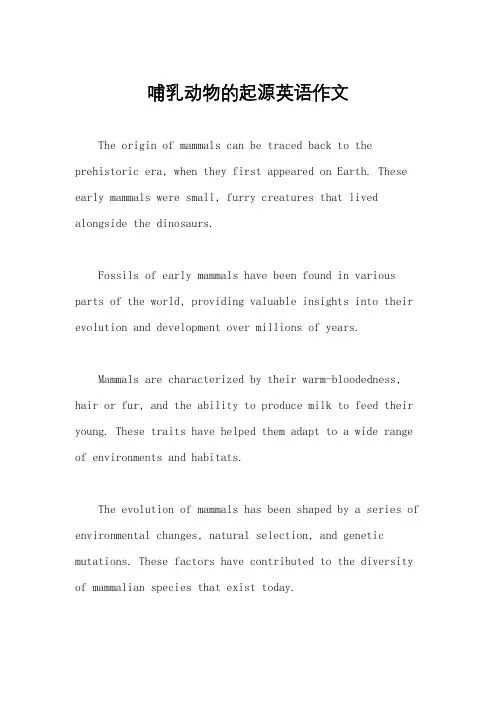
哺乳动物的起源英语作文The origin of mammals can be traced back to the prehistoric era, when they first appeared on Earth. These early mammals were small, furry creatures that lived alongside the dinosaurs.Fossils of early mammals have been found in various parts of the world, providing valuable insights into their evolution and development over millions of years.Mammals are characterized by their warm-bloodedness, hair or fur, and the ability to produce milk to feed their young. These traits have helped them adapt to a wide range of environments and habitats.The evolution of mammals has been shaped by a series of environmental changes, natural selection, and genetic mutations. These factors have contributed to the diversity of mammalian species that exist today.Today, mammals can be found in almost every corner of the world, from the freezing Arctic tundra to the scorching deserts of Africa. They have evolved to fill a wide range of ecological niches and play crucial roles in their respective ecosystems.The study of mammalian evolution continues to be a fascinating and complex field of research, as scientists uncover new evidence and insights into the origins and development of these remarkable creatures.。

哺乳动物的特点英语作文英文回答:As a mammal, I possess a unique set of characteristics that distinguish me from other animal classes. One of my most defining features is my ability to produce milk to feed my young. This nourishment provides my offspring with essential nutrients for their growth and development.Another hallmark of my mammalian status is the presence of fur or hair. This insulating layer serves as protection from the elements, helping me maintain a constant body temperature. It also provides camouflage, aiding in my survival amidst diverse environments.My body plan is also a testament to my mammalian heritage. As a warm-blooded animal, my internal body temperature is largely unaffected by external conditions. This allows me to remain active and maintain a high metabolic rate regardless of the surrounding climate.Moreover, my respiratory system is highly efficient. I possess a diaphragm, a muscular partition that separates my thoracic cavity from my abdominal cavity. This muscle plays a pivotal role in breathing, enabling me to take in large amounts of oxygen, which is essential for my energy production.My circulatory system is also well-developed. As a mammal, I have a four-chambered heart that pumps oxygenated blood throughout my body. This ensures that all my organs and tissues receive the vital nutrients they need to function properly.In terms of reproduction, I am a viviparous animal. This means that I give birth to live young rather than laying eggs. My offspring develop within a uterus, where they receive nourishment and protection until they are ready to be born.中文回答:作为一个哺乳动物,我拥有独特的一系列特征,将我从其他动物类别中区别开来。
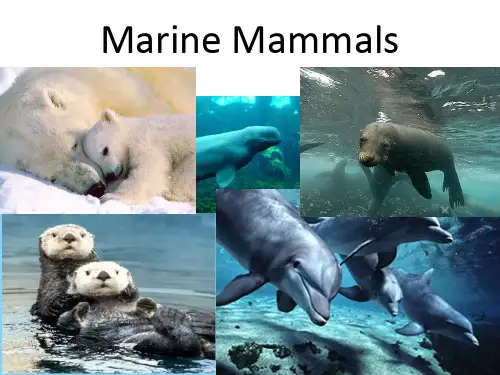
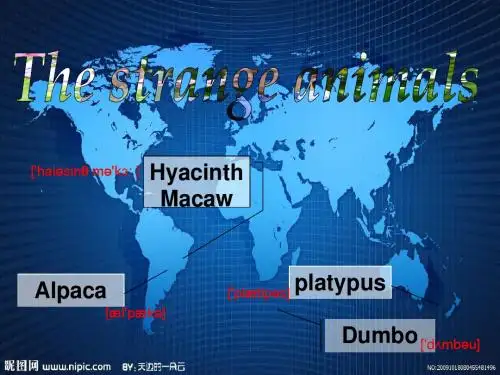
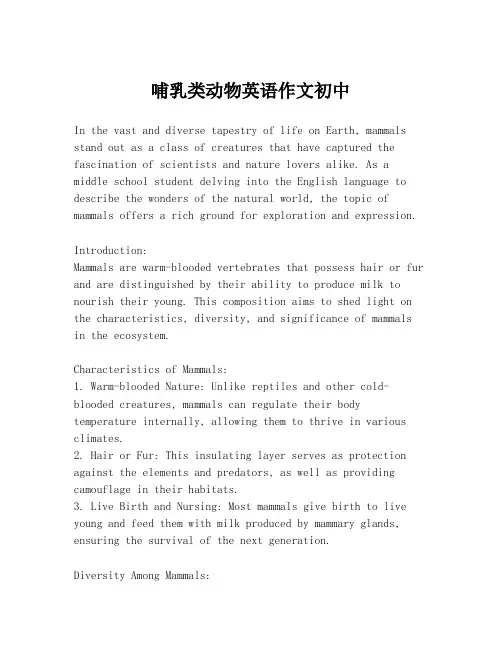
哺乳类动物英语作文初中In the vast and diverse tapestry of life on Earth, mammals stand out as a class of creatures that have captured the fascination of scientists and nature lovers alike. As a middle school student delving into the English language to describe the wonders of the natural world, the topic of mammals offers a rich ground for exploration and expression.Introduction:Mammals are warm-blooded vertebrates that possess hair or fur and are distinguished by their ability to produce milk to nourish their young. This composition aims to shed light on the characteristics, diversity, and significance of mammalsin the ecosystem.Characteristics of Mammals:1. Warm-blooded Nature: Unlike reptiles and other cold-blooded creatures, mammals can regulate their body temperature internally, allowing them to thrive in various climates.2. Hair or Fur: This insulating layer serves as protection against the elements and predators, as well as providing camouflage in their habitats.3. Live Birth and Nursing: Most mammals give birth to live young and feed them with milk produced by mammary glands, ensuring the survival of the next generation.Diversity Among Mammals:The class Mammalia is incredibly diverse, encompassing species as small as the bumblebee bat to the majestic blue whale. They inhabit every continent, from the depths of the ocean to the highest mountain peaks.1. Marsupials: Unique among mammals, marsupials like kangaroos and opossums give birth to underdeveloped youngthat continue to grow in a pouch outside the womb.2. Cetaceans: Creatures such as whales and dolphins are fully aquatic, showcasing an adaptation to life in the water.3. Primates: Closely related to humans, primates like chimpanzees and gorillas exhibit advanced cognitive abilities and complex social structures.Ecosystem Roles:Mammals play crucial roles in their ecosystems. They are pollinators, seed dispersers, predators, and prey, contributing to the balance of biodiversity.1. Predators: As top predators, mammals like lions and wolves help control populations of herbivores, preventing overgrazing and maintaining the health of plant life.2. Herbivores: Creatures such as deer and elephants are essential in seed dispersal, which promotes plant diversity and forest regeneration.Conservation Challenges:Despite their adaptability, many mammals face threats due to human activities, including habitat destruction, climate change, and poaching.1. Habitat Loss: Deforestation and urbanization have led tothe loss of natural habitats, pushing some species towards extinction.2. Climate Change: Altered weather patterns and temperatures can disrupt the life cycles of mammals, affecting their food sources and reproductive success.Conclusion:Mammals are an integral part of our planet's biodiversity,and their study offers a window into the complex interplay of life on Earth. As we continue to learn about thesefascinating creatures, it is imperative that we also work towards their conservation. Through education and responsible actions, we can help ensure the survival of mammals forfuture generations to appreciate and study.Word Bank:- Vertebrates: animals with a backbone- Marsupials: mammals that carry their young in a pouch- Cetaceans: a group of aquatic mammals that includes whales and dolphins- Biodiversity: the variety of life in a particular ecosystem or habitat- Extinction: the state of a species being completely wipedout- Conservation: the protection of nature and wildlifeThis composition provides a comprehensive overview of mammals, their characteristics, diversity, roles in the ecosystem, and the challenges they face. It is designed to engage middleschool students in the topic while enhancing their English writing skills.。
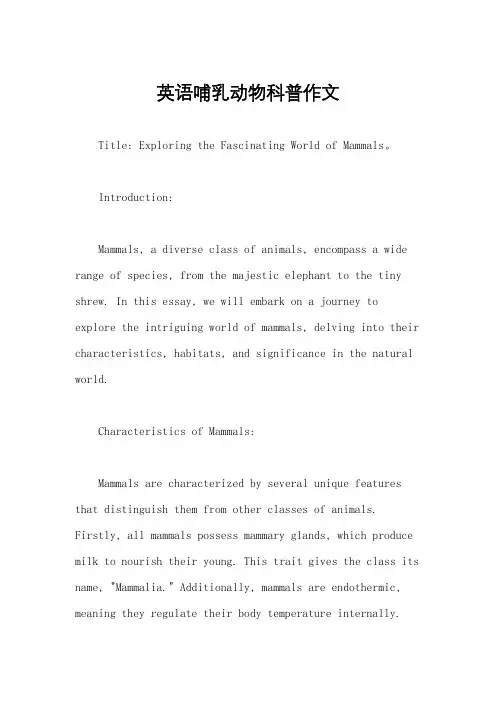
英语哺乳动物科普作文Title: Exploring the Fascinating World of Mammals。
Introduction:Mammals, a diverse class of animals, encompass a wide range of species, from the majestic elephant to the tiny shrew. In this essay, we will embark on a journey to explore the intriguing world of mammals, delving into their characteristics, habitats, and significance in the natural world.Characteristics of Mammals:Mammals are characterized by several unique features that distinguish them from other classes of animals. Firstly, all mammals possess mammary glands, which produce milk to nourish their young. This trait gives the class its name, "Mammalia." Additionally, mammals are endothermic, meaning they regulate their body temperature internally.This ability enables them to inhabit diverse environments ranging from polar regions to tropical rainforests.Another distinguishing feature of mammals is their hair or fur, which varies greatly in texture, color, and density among different species. Hair serves various functions, including insulation, camouflage, and sensory perception. Furthermore, mammals have specialized teeth adapted totheir dietary preferences, whether they are herbivores, carnivores, or omnivores.Habitats and Diversity:Mammals inhabit virtually every corner of the Earth, from the depths of oceans to the highest mountain peaks. They occupy diverse ecosystems, including forests, grasslands, deserts, and urban areas. This adaptability has contributed to the extraordinary diversity of mammalian species, which number over 6,000.Among the most iconic mammalian habitats are the African savannas, home to elephants, lions, and giraffes.In the Amazon rainforest, an unparalleled wealth of mammalian biodiversity thrives, including jaguars, sloths, and monkeys. From the Arctic tundra to the Australian outback, mammals have successfully colonized a vast array of environments through evolutionary adaptations.Significance in the Natural World:Mammals play crucial roles in ecosystem dynamics and are integral to the balance of natural communities. As herbivores, they influence plant populations through grazing and seed dispersal, shaping the structure of terrestrial landscapes. Predatory mammals help regulate prey populations, preventing overgrazing and promoting biodiversity.Moreover, mammals contribute to nutrient cycling and soil fertility through their activities, such as burrowing and waste deposition. In aquatic ecosystems, marine mammals like whales and dolphins play vital roles in nutrient transport and plankton regulation. Additionally, mammals serve as indicators of environmental health, reflectingchanges in habitat quality and ecosystem stability.Conservation Challenges:Despite their ecological importance, many mammalian species face numerous threats to their survival, primarily due to human activities. Habitat destruction, caused by deforestation, urbanization, and agricultural expansion, poses a significant threat to countless mammal populations worldwide. Climate change exacerbates these pressures, altering habitat suitability and disrupting ecological relationships.Furthermore, illegal wildlife trade, poaching, and hunting endanger numerous mammalian species, driving them towards extinction. Conservation efforts are essential to safeguarding vulnerable mammals and preserving biodiversity for future generations. Conservation initiatives include habitat restoration, protected area establishment, and community-based conservation projects aimed at promoting coexistence between humans and wildlife.Conclusion:In conclusion, mammals represent a remarkable and diverse group of animals that inhabit various ecosystems worldwide. Their unique characteristics, habitats, and ecological roles highlight their significance in the natural world. However, conservation challenges threaten many mammalian species, underscoring the urgency of concerted efforts to protect and preserve these extraordinary creatures for the benefit of ecosystems and humanity as a whole.。
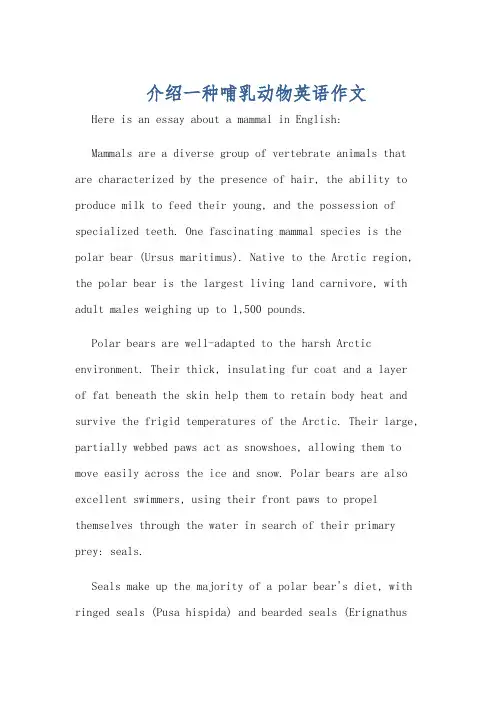
介绍一种哺乳动物英语作文Here is an essay about a mammal in English:Mammals are a diverse group of vertebrate animals that are characterized by the presence of hair, the ability to produce milk to feed their young, and the possession of specialized teeth. One fascinating mammal species is the polar bear (Ursus maritimus). Native to the Arctic region, the polar bear is the largest living land carnivore, with adult males weighing up to 1,500 pounds.Polar bears are well-adapted to the harsh Arctic environment. Their thick, insulating fur coat and a layer of fat beneath the skin help them to retain body heat and survive the frigid temperatures of the Arctic. Their large, partially webbed paws act as snowshoes, allowing them to move easily across the ice and snow. Polar bears are also excellent swimmers, using their front paws to propel themselves through the water in search of their primary prey: seals.Seals make up the majority of a polar bear's diet, with ringed seals (Pusa hispida) and bearded seals (Erignathusbarbatus) being their preferred sources of food. Polar bears will also consume other marine life, such as fish, birds, and even the occasional whale carcass. Their hunting strategy involves waiting patiently at seal breathing holes or seal pupping lairs, or stalking and ambushing seals on the ice.One of the most remarkable adaptations of the polar bear is its ability to go for extended periods without food. During the summer months, when sea ice melts and seals become more difficult to find, polar bears may fast for several weeks or even months. They are able to do this by entering a state of "walking hibernation," where their metabolism slows down, and they conserve energy by resting and moving less.Sadly, the polar bear's future is under threat due to the effects of climate change. As the Arctic region warms and sea ice melts at an alarming rate, polar bears are finding it increasingly difficult to find and catch their seal prey. This has led to a decline in their population, with the International Union for Conservation of Nature (IUCN) listing the polar bear as a "vulnerable" species.Conservation efforts are underway to protect the polar bear and its Arctic habitat. This includes measures to reduce greenhouse gas emissions, establish protected areas, and limit human activities that may disturb or harm polar bears. Additionally, research is being conducted to better understand the impacts of climate change on polar bears and to develop strategies for their long-term survival.In conclusion, the polar bear is a remarkable and captivating mammal that is adapted to the harsh Arctic environment. However, the species is facing significant challenges due to the effects of climate change, and it is crucial that we take action to protect this iconic animal and its fragile ecosystem.现在用中文总结一下:极地熊是一种非常独特的哺乳动物。
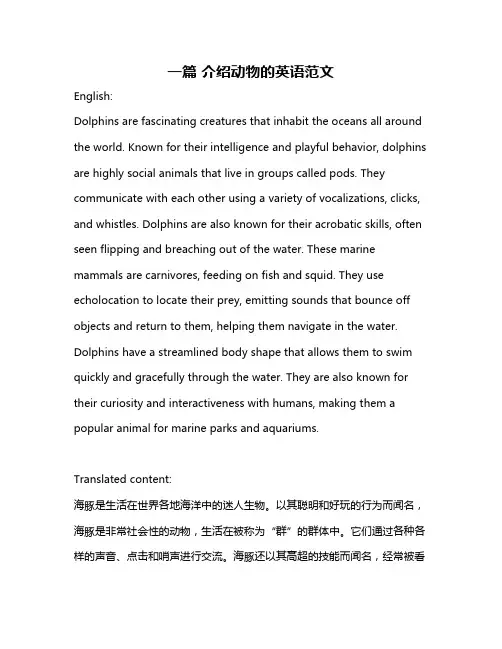
一篇介绍动物的英语范文English:Dolphins are fascinating creatures that inhabit the oceans all around the world. Known for their intelligence and playful behavior, dolphins are highly social animals that live in groups called pods. They communicate with each other using a variety of vocalizations, clicks, and whistles. Dolphins are also known for their acrobatic skills, often seen flipping and breaching out of the water. These marine mammals are carnivores, feeding on fish and squid. They use echolocation to locate their prey, emitting sounds that bounce off objects and return to them, helping them navigate in the water. Dolphins have a streamlined body shape that allows them to swim quickly and gracefully through the water. They are also known for their curiosity and interactiveness with humans, making them a popular animal for marine parks and aquariums.Translated content:海豚是生活在世界各地海洋中的迷人生物。

哺乳动物作文300字左右英文回答:Mammals.Mammals are a diverse group of vertebrates that include humans, dogs, cats, horses, and whales. They are characterized by several key features, including:Mammary glands: Mammals are the only animals that produce milk to feed their young.Hair: Mammals have hair or fur, which helps toinsulate their bodies.Endothermic metabolism: Mammals are warm-blooded, meaning that they can maintain a constant body temperature regardless of the external environment.Diaphragm: Mammals have a diaphragm, which is a musclethat separates the chest cavity from the abdominal cavity.Mammals are found all over the world, in a wide variety of habitats. They range in size from the tiny bumblebee bat, which weighs only 2 grams, to the massive blue whale, which can weigh up to 200 tons.Mammals are an important part of the ecosystem. Theyplay a role in pollination, seed dispersal, and nutrient cycling. They are also a food source for many other animals.中文回答:哺乳动物。

哺乳动物200字作文英文回答:Mammals are a class of animals that are distinguished by their ability to produce milk for feeding their young. They are warm-blooded, have hair or fur, and most species give birth to live young (viviparity), rather than laying eggs (oviparity). Mammals are found in all major habitats around the world, from the oceans to the deserts. There are over 5,000 species of mammals, ranging in size from thetiny bumblebee bat to the massive blue whale.Mammals are divided into three main groups: monotremes, marsupials, and placentals. Monotremes are the most primitive mammals, and they lay eggs like reptiles. Marsupials are more advanced than monotremes, and they give birth to live young that are underdeveloped and continue to develop in a pouch on the mother's body. Placentals are the most advanced mammals, and they give birth to live young that are fully developed.Mammals have a wide range of adaptations that allowthem to survive in different habitats. These adaptations include their ability to produce milk, their warm-bloodedness, their hair or fur, and their ability to give birth to live young. Mammals also have a highly developed nervous system and a complex social structure.中文回答:哺乳动物是一类动物,其特点是能分泌乳汁喂养幼崽。